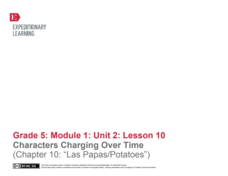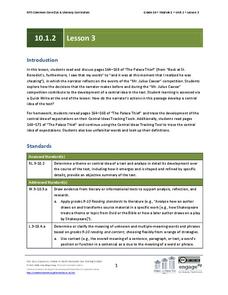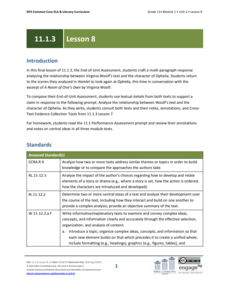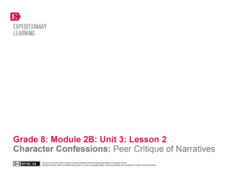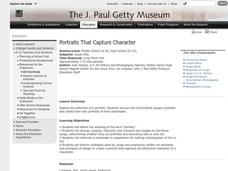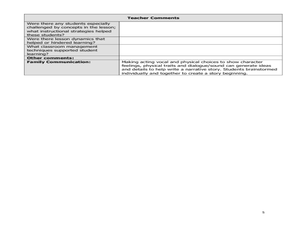EngageNY
Characters Changing Over Time (Chapter 10: "Las Papas/Potatos")
Engage further in Esperanza Rising with a focus on close reading and metaphor. Class members zero in on the tenth chapter, examining characters and big ideas. Pupils discuss the text in small groups and as a whole class, and...
EngageNY
Grade 9 ELA Module 1, Unit 1, Lesson 12
Finding the central idea in a text can be as simple as deciphering the correct pieces of supporting evidence. As your class reads Stage 4 of "St. Lucy's Home for Girls Raised by Wolves" by Karen Russell, they analyze the interactions...
EngageNY
Grade 9 ELA Module 1, Unit 1, Lesson 17
Eighth graders demonstrate their understanding with the final assessment in a literary analysis unit based on Karen Russell's short story, "St. Lucy's Home for Girls Raised by Wolves." Having prepared for the assessment in the last few...
EngageNY
Grade 10 ELA Module 1: Unit 3, Lesson 13
A parent's influence on a child is one of the most formative factors in developing life. Discuss the importance of the parental relationships in Amy Tan's The Joy Luck Club and H.G. Bissinger's Friday Night Lights with a written...
EngageNY
Grade 10 ELA Module 1: Unit 2, Lesson 3
Readers of "The Palace Thief" continue examining Ethan Canin’s short story and consider how the narrator's actions develop the central idea of how one's expectations and the expectations of others influence behavior.
EngageNY
Grade 11 ELA Module 1: Unit 2, Lesson 6
How does Shakespeare develop the characters of Laertes and Ophelia in Hamlet? Scholars complete a Quick Write to answer the question. They also continue reading and discussing the first act of the play.
EngageNY
Grade 11 ELA Module 1: Unit 3, Lesson 8
How does the theme of gender inequality develop in Virginia Woolf's A Room of One's Own and Shakespeare's Hamlet? Pupils craft a multi-paragraph response to analyze the relationship between the texts. They use evidence from both works to...
EngageNY
Grade 11 ELA Module 1: Unit 3, Lesson 7
How might two completely different texts address similar topics and themes? Using the penultimate instructional activity from the eight-part Grade 11 ELA Module 1: Unit 3 series, scholars review the central ideas they developed in a...
EngageNY
Character Confessions: Peer Critique of Narratives
Shake up the writing process with a peer critique. The second of four lessons in the Grade 8 ELA Module 2B, Unit 3 series first has young writers compare their interpretations of a scene from William Shakespeare's A Midsummer Night's...
Curated OER
Wax Museum
Student role play as statues in a wax museum while the teacher takes the role of the curator. They stand in a static position until the curator leaves the room. They interact until the curator returns at which point they freeze. Now they...
Curated OER
Character, You Say? Prove It!
Students discuss character traits, and complete a character map and a Venn diagram for selected characters in their assigned text.
Curated OER
Find a Character, Tell a Story
Fourth graders choose a character from a magazine, complete a character sketch, and develop a short story placing this character in a situation. They utilize a worksheet imbedded in this plan which guides them through creating their...
Curated OER
Analyzing Relationships
Students explore relationships between story characters. In this story elements and reading comprehension lesson, students generate character traits of the characters in Bridge to Terabithia, by Katherine Paterson. Students describe...
Curated OER
Descriptive Character Analysis
Students visualize a character or event and personalize it through drawings.
Curated OER
In the Time of Butterflies: Character Analysis
Tenth graders read about the life in the Dominican Republic during the Trujillo Regime. After exploring a book, "The Time of the Butterflies," students describe the sisters and their lives. They complete a graphic organizer and write a...
Curated OER
Portraits That Capture Character
Students analyze two of Dorothea Lange's portraits and create their own portraits of classmates. In this portrait analysis lesson, students define portrait and discuss two images of Lange's. Students interview a classmate and use Lange's...
Curated OER
Cinderella Stories
Learners listen to the Scottish tale, The Princess and the Golden Shoes, creating a character chart. They develop a newspaper containing news stories, personality profiles, and editorials regarding The Princess and the Golden Shoes.
Curated OER
Yes, You Can!
Students examine the concept of encouragement. In this encouragement and character lesson, students participate in an active read aloud of Mary Grace's, Amazing Grace. They draw a picture in their journal of a time that they needed...
Curated OER
Character Trading Card
In this character trading card worksheet, learners utilize a trading card template to develop more details about their favorite character from a novel they have read. Students interview their fictional character.
Curated OER
Acting as a Pre-write Tool
Second graders use acting to help them in a prewriting activity to develop a story. In this prewriting lesson plan, 2nd graders form a character map and brainstorm ideas for their story.
Curated OER
Cold Sassy Tree: Multicultural Strategy
Analyze the characters in Olive Ann Burns's Cold Sassy Tree with this assignment. After reading the majority of the novel, class members choose a character and make a visual representation of the character, including any important...
Curated OER
Twisted Tales
Experience how a story can drastically change when the point of view is altered. Young scholars first read a review of Disney's film Tarzan, focusing on how the point of view in the classic story is important. They then select...
Curated OER
Dear Diary
Work on narrative writing with this lesson, in which middle schoolers analyze the characters from a selected piece of literature and write narrative diary pieces as the character. They work to understand the point of view of the...
Curated OER
Mystery Lessons
Learn about mysteries with your readers. They will investigate plot, basic elements of mystery, famous characters, and become familiar with genre vocabulary. Bring in props and mystery books to begin and then have learners create story...
